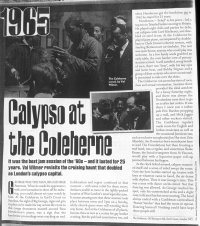brixtonscot
Well-Known Member
Some info on jazz/calypso/steel pan sessions on Sunday afternoons at Colherne pub in Earls Court , and beginnings of Notting Hill Carnival.
-
In 1966 the community worker Rhaune Laslett invited Henderson to bring a three-piece steel band to play for the first Notting Hill fayre and pageant, an event she had organised in conjunction with the London Free School and the photographer, writer and activist John “Hoppy” Hopkins. The small steel band arrived at Portobello Green accompanied by a crowd of regulars from the Coleherne pub, and after having played for some time in a standing position, Henderson suggested everyone should embark on a road march. The procession, joined by the public, was repeated the following day, and became the first manifestation of what has since grown into an international event attended by more than one million revellers each year.
Russ Henderson obituary
-
In 1966 the community worker Rhaune Laslett invited Henderson to bring a three-piece steel band to play for the first Notting Hill fayre and pageant, an event she had organised in conjunction with the London Free School and the photographer, writer and activist John “Hoppy” Hopkins. The small steel band arrived at Portobello Green accompanied by a crowd of regulars from the Coleherne pub, and after having played for some time in a standing position, Henderson suggested everyone should embark on a road march. The procession, joined by the public, was repeated the following day, and became the first manifestation of what has since grown into an international event attended by more than one million revellers each year.
Russ Henderson obituary
Last edited:

